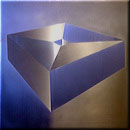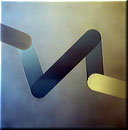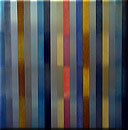|
14.SATURDAY
MAY 21 2005
WEEKENDEXTRA THE WESTAUSTRALIAN
VISUAL ARTS
Ric Spencer
The art of leisure
Placing art in the realm of leisure has been a favourite pastime of
history. Symbolic of a society at ease with itself and flexing its
right to relax, art is viewed by some as the product of those on a
philosophical sabbatical.
This tension between the hobby of making and the industry of art is
a favourite hunting ground of Brian McKay. It seems he believes art
should hold a pivotal position in the structure of society. Certainly,
this is what is gained from looking at his work. That art is parodied
as a leisure pursuit is frustrating to McKay and in the current pieces
at Galerie Dusseldorf in Mosman Park this frustration takes the form
of irony, both in symbolism and material process.
The works - for the most part are McKay's current signature process,
a combination of automotive paint on etched and sealed aluminium.
Some images attempt to create a depth through automotive paint colours
but it was the "colourless" works that really grabbed me.
The cross etching he uses in these to garner texture makes the viewer's
mobility integral to defining the image. Depending on the light, the
images of a boat, shell or deckchair acquire rotation themselves and
differing solidity through tonal values. Manipulating the viewer into
giving the images sustenance is a wonderful comment. It sums up the
symbols as false idols rather than iconography, illusions of materialism
rather than symbols holding any substance.
This idea of falsity or lie is important in considering how McKay
views the relationship between art
and industrial society. McKay's works on aluminium muse over the way
our landscape has been formed through the relationship between industry,
leisure and art.
His work tells of the false icon of increased leisure time which has
been promised to us by industrialise society since the revolution
of mechanised labour some 300 years ago. The false symbols of security,
like boats and deckchairs swimming across aluminium, caught me thinking
about the act of looking, too. Having time to look is directly related
to material security; one gives the opportunity for the other.
The use of aluminium in McKay's work is very contemporary. The aluminium
is beautiful to the eye and placating to our senses. Further to this,
it exonerates us for our sins of over-production, beautiful things
that have been made from industrial processes.
'The cross etching he uses in these to garner texture makes the viewer's
mobility integral to defining the image.'
In McKay's working method, desire is OK because it drives us to understand
our environment.
Yes, through industria1isation we have raped our planet but in doing
so we subconsciously honour that same planet through replicating its
beautiful organic forms and attempting to understand the light that
builds these forms for our eyes.
The show at Dusseldorf is a conglomeration of pieces that I've seen
in various shows in different places before. But put his works that
concern structural elements alongside the works with icons and it
begins to read like a philosophical reasoning for why we are drawn
to continually
wanting more in our lives.
This world and its light and forms are so beautiful that it seems
only natural we should desire to produce beauty ourselves.
At first glance McKay's images are difficult to grasp.
They need time to see the irony and levels of connective thinking
between the process, the form and the image.
He doesn't own the picture plane in his process and along with the
mechanic craft quality of these images, he implies a lack of authorship
that simultaneously critiques the depth of icons as well as artist's
ideas.
His ideas, like his sails, slip across the surface of the aluminium
- they are barely hanging on. This is why McKay's work is so important
to art today. His work understands and speaks of the precarious labour
which is art-making within an industrial society bent on production.
There is an intense input of time and scrutiny involved in McKay's
art-making, an intensity that is far removed from the art that much
of society views with envy or disaffectedness as a whim of leisure
and a waste of time.
|



Images
reproduced: Ambiguos Box, Quintet, Celebration
|
|